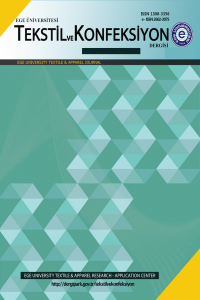MEKANİK TEST KOŞULLARININ TEKSTİL BAZLI UZAMA SENSÖRLERİNİN ALGILAMA ÖZELLİKLERİNE ETKİSİNİN İNCELENMESİ ÜZERİNE BİR ARAŞTIRMA
Örme sensörler, gümüş kaplı iplik, uzama sensörleri, mekanik test, elastomerik iplik
INVESTIGATION OF THE MECHANICAL TESTING CONDITIONS ON SENSING PROPERTIES OF TEXTILE-BASED STRAIN SENSOR
___
- 1. Zeng, W., et al., Fiber-Based Wearable Electronics: A Review of Materials, Fabrication, Devices, and Applications. Advanced Materials, 2014. 26(31): p.5310-5336.
- 2. Fleury, A., M. Sugar, and T. Chau, E-textiles in Clinical Rehabilitation: A Scoping Review. Electronics, 2015. 4(1): p. 173-203.
- 3. Patel, S., et al., A review of wearable sensors and systems with application in rehabilitation. Journal of neuroengineering and rehabilitation, 2012. 9(12): p.1-17.
- 4. Ferreira MS, Bierlich J, Becker M, Schuster K, Santos JL, Frazão O. Ultra-high sensitive strain sensor based on post-processed optical fiber Bragg grating. Fibers. 2014.2(2):142-9.
- 5. Husain MD, Kennon R. Preliminary Investigations into the Development of Textile Based Temperature Sensor for Healthcare Applications. Fibers. 2013.1(1):2-10.
- 6. Kirstein, T., et al., Wearable Computing Sytems - Electronic Textiles, in Wearable electronics and photonics, X. Tao, Editor. 2005, Crc Press Boca Raton, FL. p. 177-197.
- 7. Usher, M. and D. Keating, Sensors and Transducers: Characteristics, Applications, Instrumentation. Interfacing. Maxmillan, 1996.
- 8. Atalay, O., W. Kennon, and M. Husain, Textile-Based Weft Knitted Strain Sensors: Effect of Fabric Parameters on Sensor Properties. Sensors, 2013. 13(8): p. 11114-11127.
- 9. Wijesiriwardana, R., Inductive fiber-meshed strain and displacement transducers for respiratory measuring systems and motion capturing systems. Sensors Journal, IEEE, 2006. 6(3): p. 571-579.
- 10. Yang, C., et al. Textile-based capacitive sensor for a wireless wearable breath monitoring system. in Consumer Electronics (ICCE), 2014 IEEE International Conference on. 2014. IEEE.
- 11. Atalay, O. and W.R. Kennon, Knitted Strain Sensors: Impact of Design Parameters on Sensing Properties. Sensors, 2014. 14(3): p. 4712-4730.
- 12. Krajewski, A.S., et al., Piezoelectric Force Response of Novel 2D Textile Based PVDF Sensors. Sensors Journal, IEEE, 2013. 13(12): p. 4743-4748.
- 13. Husain, O.A., Richard Kennon, , Effect of Strain and Humidity on the Performance of Temperature Sensing Fabric. International Journal of Textile Science , 2013. 2(4): p. 105-112.
- 14. Chiarugi, F., et al. Measurement of heart rate and respiratory rate using a textile-based wearable device in heart failure patients. in Computers in Cardiology, 2008. 2008. IEEE.
- 15. Atalay, O., W.R. Kennon, and E. Demirok, Weft-Knitted Strain Sensor for Monitoring Respiratory Rate and Its Electro-Mechanical Modeling. Sensors Journal, IEEE, 2015. 15(1): p. 110-122.
- 16. Gilsoo, C., et al., Performance Evaluation of Textile-Based Electrodes and Motion Sensors for Smart Clothing. Sensors Journal, IEEE, 2011. 11(12): p. 3183-3193.
- 17. Holleczek, T., et al. Textile pressure sensors for sports applications. in Sensors, 2010 IEEE. 2010.
- 18. Window, A.L. and G.S. Holister, Strain gauge technology. 1982: Applied science publishers.
- 19. Wijesiriwardana, R., T. Dias, and S. Mukhopadhyay. Resistive fibre-meshed transducers. in Proceedings of the 7th IEEE International Symposium on Wearable Computers. 2003. IEEE Computer Society.
- 20. Atalay, O., et al., Comparative study of the weft-knitted strain sensors. Journal of Industrial Textiles, 2015: p. 1528083715619948.
- 21. Guo, L., L. Berglin, and H. Mattila, Improvement of electro-mechanical properties of strain sensors made of elastic-conductive hybrid yarns. Textile research journal, 2012. 82(19): p. 1937-1947.
- 22. Li, L.F. and Y.S. Ding, Design and analysis of woven structure-based flexible strain sensor. Chinese Journal of Sensors and Actuators, 2008. 21(7): p.1132-1136.
- 23. Bashir, T., et al., Stretch sensing properties of conductive knitted structures of PEDOT-coated viscose and polyester yarns. Textile Research Journal, 2014.84(3): p. 323-334.
- 24. Krucińska, I., Development of Screen-Printed Breathing Rate Sensors. FIBRES & TEXTILES in Eastern Europe, 2013. 21(6): p. 102.
- ISSN: 1300-3356
- Yayın Aralığı: Yılda 4 Sayı
- Başlangıç: 1991
- Yayıncı: Ege Üniversitesi
MODA TASARIMI EĞİTİMİNDE GİYSİ YAPISINI ANLAYARAK YARATICILIĞI GELİŞTİRMEYE YÖNELİK BİR YAKLAŞIM
COMPARISON OF SPECTROPHOTOMETRIC AND DIGIEYE COLOUR MEASUREMENTS OF WOVEN FABRICS
Małgorzata MATUSİAK, Anetta WALAWSKA, Wioletta SYBİLSKA
FAZLA KİLOLU ÇOCUKLARA YÖNELİK ARA BEDEN KALIP ÇALIŞMASI
DOKUMA KUMAŞ ÖZELLİKLERİNİN YAPAY SİNİR AĞLARI İLE TAHMİN EDİLMESİ ÜZERİNE BİR ARAŞTIRMA
KANCALI DOKUMA MAKİNASINDA KENAR TELEFİ UZUNLUĞUNUN GÖRÜNTÜ ANALİZ TEKNİĞİYLE İNCELENMESİ
Rafet AKDENİZ, H. Ziya ÖZEK, Göktekin DURUSOY
Asif Elahi MANGAT, Lubos HES, Vladimir BAJZİK, Zuhaib AHMAD
Ozgur ATALAY, Asli ATALAY, Muhammad Dawood HUSAIN
